In today’s data-driven marketing landscape, accurately measuring the success of your advertising efforts is crucial. While online conversion tracking has been a staple for understanding digital campaign performance, it only captures part of the customer journey. This is where LinkedIn Ads Offline Conversion Tracking comes into play.
By linking offline actions—such as in-store purchases, phone calls, and event registrations—to your LinkedIn ad campaigns, you gain a more complete picture of your marketing impact. This powerful tool enables businesses to track and attribute real-world outcomes to their online ads, providing a holistic view of campaign effectiveness and a clearer understanding of return on investment (ROI).
Even more importantly, offline conversion tracking enables you to maximise the AI of LinkedIn Ads by training the bidding algorithm to meet your goals using your own first-party data, resulting in improved targeting and optimisation.
In this blog, we’ll explore the intricacies of LinkedIn Ads Offline Conversion Tracking, how it differs from online tracking, and why combining both methods is essential for a comprehensive marketing strategy. Whether you’re looking to improve lead quality, optimise ad spend, or better understand your customer journey, offline conversion tracking offers the insights needed to make data-driven decisions that drive business success.
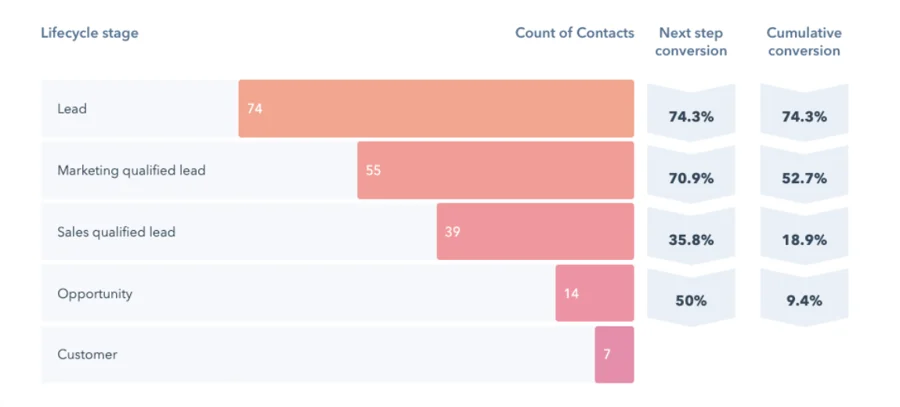
What is LinkedIn Ads Offline Conversion Tracking?
LinkedIn Ads Offline Conversion Tracking allows you to measure and attribute offline actions—such as sales made in a physical store, leads generated from a phone call, or registrations completed at an event—to your LinkedIn ad campaigns. By connecting these offline conversions to your online advertising efforts, you gain a holistic view of your campaign performance and a more accurate understanding of your ROI.
Offline conversion tracking enables businesses to measure the impact of LinkedIn advertisements on real-world outcomes, such as in-store purchases, phone orders, and service bookings. This functionality compares offline conversion data from physical interactions against the list of users who interacted with your ads, offering a clear view of campaign effectiveness.
LinkedIn Offline Conversion tracking enables advertisers to:
- Upload data about offline sales and events to LinkedIn
- Match this offline activity to people who have seen or clicked on LinkedIn Ads
- Attribute offline conversions to specific LinkedIn ad campaigns
This allows businesses to track conversions that happen outside of LinkedIn, such as in-store purchases, phone orders, or other offline interactions.
What is LinkedIn Ads Online Conversion Tracking (Insight Tag)
Before diving into the intricacies of offline conversion tracking, it is crucial to first grasp the fundamentals of online conversion tracking. This understanding is vital as it provides the necessary foundation for effectively setting up and leveraging offline conversion tracking.
LinkedIn Online Conversion Tracking empowers advertisers to monitor and measure specific online actions taken by users after interacting with their ads. These actions, known as conversions, may include activities such as completing a lead form, registering for an event, or viewing key pages on a website, such as a thank you page after form submission.
Key Aspects of LinkedIn Online Conversion Tracking
Online conversion tracking in LinkedIn Ads refers to the process of attributing and measuring conversions that occur as a direct result of LinkedIn ad campaigns. The core components of this tracking process include:
Conversion Event Types: LinkedIn allows advertisers to track a variety of online conversion events, including:
- Page views
- Add to cart actions
- Purchases
- Lead generation
- Sign-ups
- Custom events tailored by the advertiser
Implementation: To track these conversions, advertisers need to implement the LinkedIn Pixel on their website. This tracking script includes a unique conversion ID and label that identifies specific actions, such as purchases, form submissions, or phone calls.
Attribution: When a user clicks on an ad and completes the desired action, the LinkedIn Pixel sends a signal to LinkedIn Ads, which then logs the conversion. The conversion is attributed to the corresponding ad and campaign, enabling advertisers to assess the performance of their campaigns.
Reporting and Optimization: Conversion tracking enriches reporting by providing detailed insights into the number of conversions, conversion rates, cost per conversion, and conversion value. These insights are crucial for optimizing bidding strategies and targeting to maximize return on investment (ROI). For instance, advertisers can utilize LinkedIn learning algorithms to optimize their campaigns for specific goals, such as achieving a target cost per action (CPA) or maximizing return on ad spend (ROAS).
Target CPA: Often used by service-oriented businesses focusing on lead generation, this strategy adjusts bids to achieve a specific cost per lead.
Target ROAS: Commonly employed by e-commerce businesses, this strategy optimizes for the highest possible sales revenue based on the ad spend.
The Benefits of Offline Conversion Tracking (Conversions API)
Implementing offline conversion tracking effectively requires thorough integration between your advertising platforms and customer relationship management systems. This integration ensures that every piece of data captured is utilised to enhance the accuracy of your tracking and the effectiveness of your campaigns.
Understanding Lead Value:
Offline conversion tracking enables you to measure the return on investment (ROI) of your online advertisements by assessing their contribution to offline sales. Offline Conversion Tracking assists LinkedIn Ads in identifying the most valuable leads. Whether you set bids manually or utilise automatic bidding, this integration ensures your expenditure is judicious. It allows you to configure LinkedIn Ads to prioritise leads that are more likely to convert into paying customers. With data on which ads and campaigns lead to actual sales, you can optimise your ad spend more effectively by focusing on the most profitable strategies.
Informed Decision-Making:
Detailed insights into which advertisements lead to offline conversions enable you to make data-driven decisions to optimise your ad creatives, bidding strategies, and overall marketing approach. Offline conversions provide a more holistic view of your advertising performance by bridging the gap between online interactions and offline sales. This is especially crucial for companies that generate leads but aim to ensure they are allocating spend to the highest quality leads with the greatest revenue value.
Improved Lead Quality with Machine Learning:
By syncing lead stages from your CRM back to LinkedIn Ads, their machine learning algorithms can identify which campaigns, ad sets and adverts generate the highest-quality leads that progress to advanced stages in your sales funnel. This allows for a more effective allocation of ad spend towards leads that are more likely to convert into revenue-generating customers.
Revenue Tracking for Lead Generation/Service Providers:
Including sales revenue value as part of the conversion tracking in LinkedIn Ads allows for a more precise measurement of advertising impact in terms of actual revenue generated, not just leads or potential sales. This is vital for companies that use LinkedIn Ads to generate leads, such as service providers. This provides a more accurate picture of which ads are driving real-world value. By understanding the full customer journey, you can better allocate your advertising budget to the campaigns, ad set targeting, and ads that drive the most value (customers and the highest sales value, not just leads).
Optimised Ad Spend:
Allocate more budget to ads that attract leads similar to those who have previously purchased your service. Avoid wasting money on ads that only attract form fillers without further engagement. Knowing which leads convert into high-quality customers allows for more strategic budgeting.
Closed-loop Marketing:
Syncing offline sales data with online advertising campaigns enables closed-loop marketing, where every stage of the customer journey, from initial contact to final sale, is tracked and analysed. This leads to continuous improvements in marketing strategies and campaign effectiveness.
Better Attribution:
Offline conversion tracking improves the attribution of sales to the correct marketing channels, reducing the uncertainty about where investments should be made. It also aids in understanding multi-touch attribution if customers interact with multiple campaigns before converting. Tracking offline conversions provides deeper insights into the customer journey, helping you understand how online interactions influence offline behaviours. This can lead to more effective targeting and personalisation strategies.
Customisation of Ad Content:
With detailed information from CRM about lead stages and customer interactions, ads can be customised to better match the needs and profiles of potential customers at different stages of their buying journey.
Enhanced Targeting:
Offline conversion data can be used to refine your audience targeting, allowing you to focus on the segments most likely to convert.
Revenue-Based Customer Scoring:
Going beyond lead scoring, offline conversion tracking can send sales revenue data back to the ad platforms, allowing you to score customers based on the revenue value they generate and their purchase frequency. This information helps optimise your advertising to achieve better results.
Comprehensive Attribution:
Directly connects offline sales and other customer activities to your LinkedIn advertising campaigns, giving you a complete view of the customer journey.
Enhanced Optimisation:
Adjusts ad spending in real-time based on the revenue generated through offline conversions, ensuring your budget is allocated to the most effective campaigns.
Lookalike Targeting:
Leverages offline customer data to create Lookalike Audiences, refining ad delivery across LinkedIn and reaching potential customers who resemble your best offline clients.
Full Impact Measurement:
Accurately measures the total impact of your LinkedIn ad campaigns, including both online and offline results, providing a holistic view of your advertising effectiveness.
Custom Audience Creation:
Allows for the creation of custom audiences based on offline interactions, enabling more precise targeting in future campaigns.
Effective Retargeting:
Enables retargeting of customers who have engaged with your business offline, increasing the likelihood of conversions by re-engaging interested prospects.
Accurate ROI Data:
Provides more accurate ROI data for ad campaigns by incorporating offline conversion data, giving a true representation of your campaign’s effectiveness.
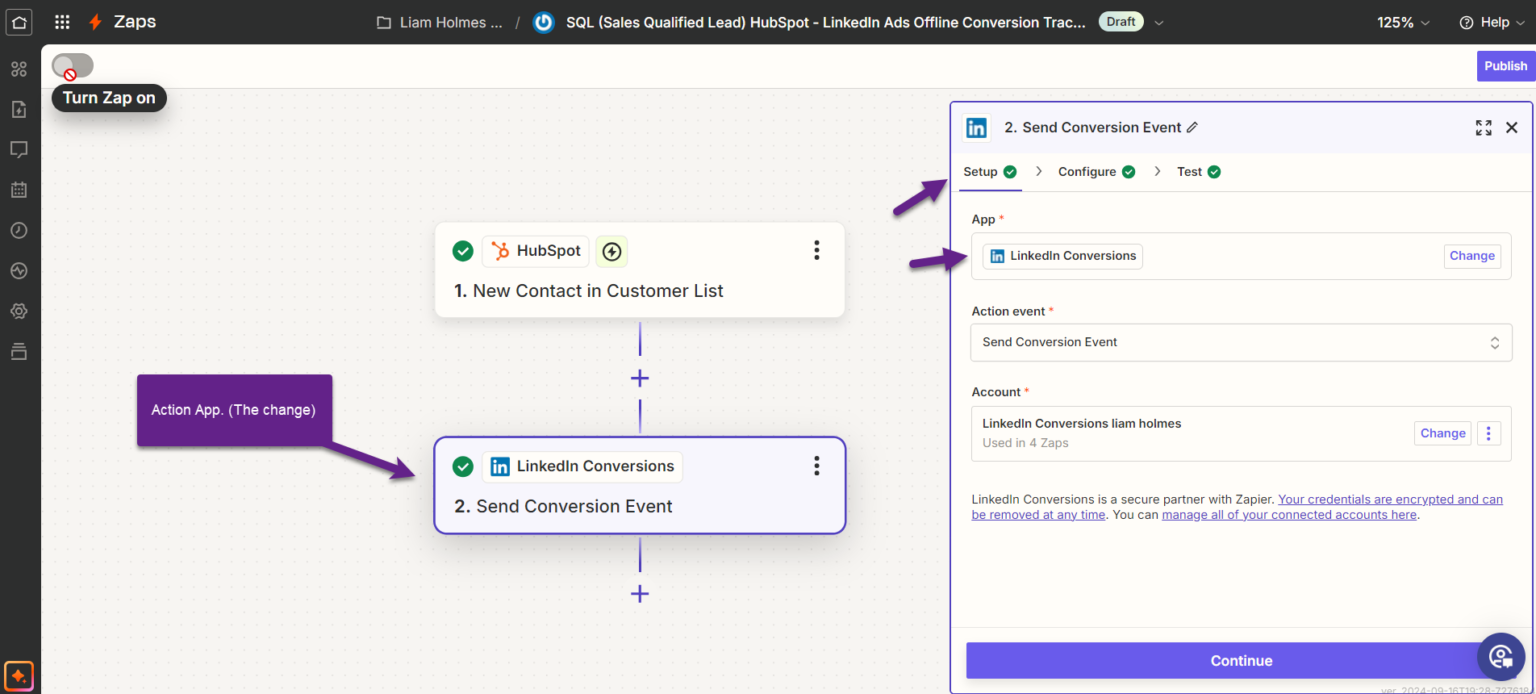
Differences Between Online Vs Offline Conversion Tracking
LinkedIn Ads Offline Conversion Tracking differs from online conversion tracking in several key ways:
Conversion Location:
Online tracking measures conversions that occur directly on your website. Offline tracking measures conversions that happen outside the immediate online environment, such as phone calls, in-store purchases, or sales after a long sales cycle.
Data Collection Method:
Online tracking typically uses the LinkedIn Insight Tag on your website to capture conversions.
Offline tracking requires manually uploading conversion data or using API integrations to import data from external sources like CRMs.
Attribution Window: Offline conversions can be attributed to ad interactions that occurred up to 90 days prior, allowing for longer sales cycles.
Data Sources:
Online tracking relies on website behaviour.
Offline tracking can incorporate data from various sources like CRM systems, sales teams, or in-person events.
Setup Process: Online tracking requires installing a tag on your website.
Offline tracking involves creating conversion rules and associating them with campaigns, as well as setting up data import methods.
Cookie Dependency:
Online tracking often relies on cookie-based tracking.
Offline tracking is a cookieless solution, making it more resilient to privacy changes in digital advertising.
Conversion Types:
Online tracking focuses on website actions like form submissions or page visits.
Offline tracking can include a wider range of conversion types, such as phone calls, in-person meetings, or manual sales processes.
Data Latency:
Online conversions are typically tracked in real-time.
Offline conversions may have a delay between the action and when it’s recorded in the system, depending on the data import frequency.
Matching Process:
Offline tracking requires LinkedIn to match the imported data with its user base, which can result in lower match rates compared to online tracking.
By combining both online and offline conversion tracking, advertisers can gain a more comprehensive view of their LinkedIn Ads performance across the entire customer journey.
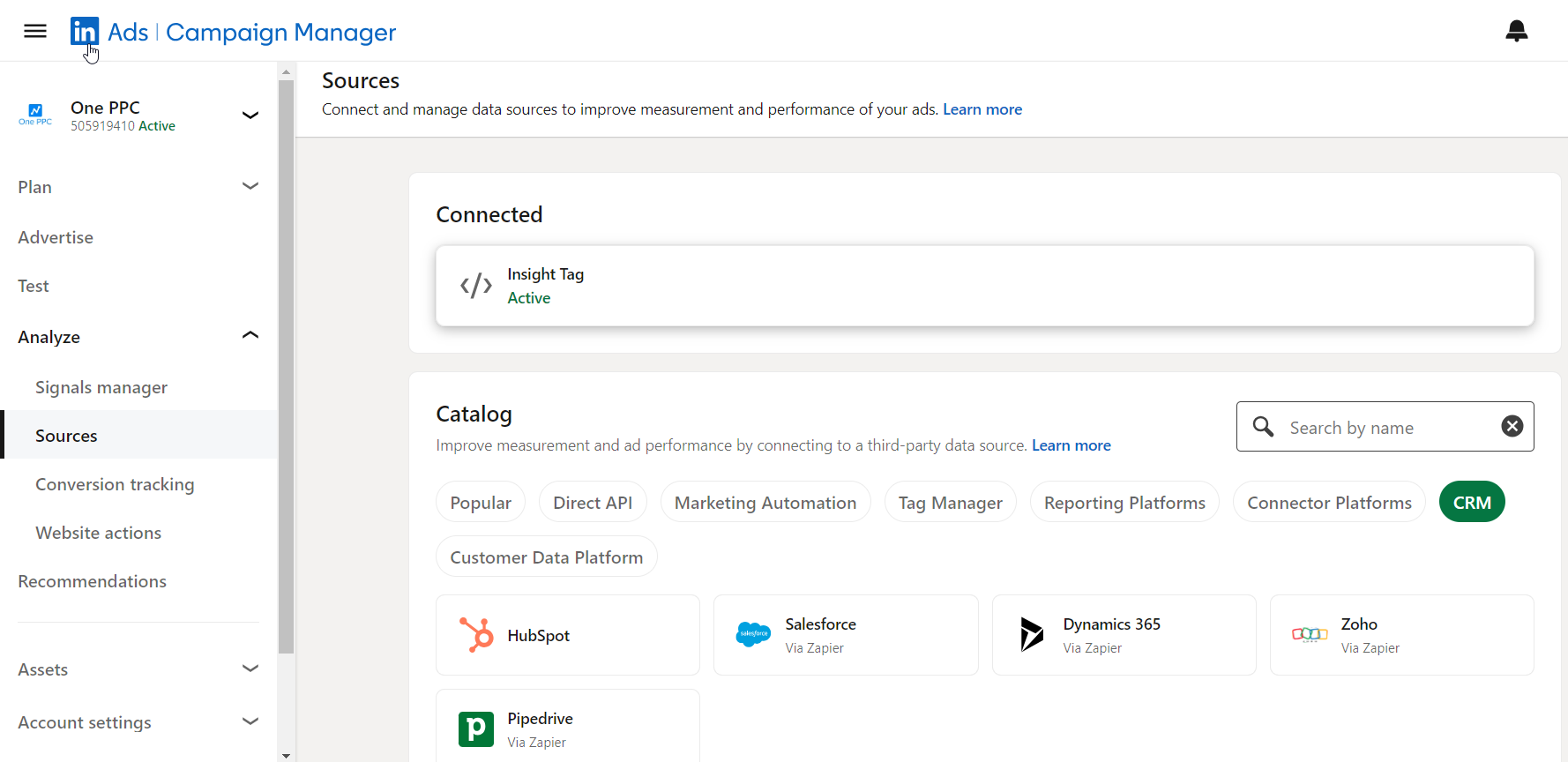
The Limitations of Online Conversion Tracking
While online conversion tracking provides valuable insights, it has limitations, particularly for lead generation companies. Not all leads generated are of equal value, and online tracking alone may not fully capture the true worth of each lead. This limitation underscores the importance of integrating offline conversion tracking to gain a more comprehensive understanding of lead quality and overall campaign effectiveness.
By combining both online and offline conversion tracking, advertisers can create a holistic view of their customer journey, allowing for more informed decision-making and more accurate assessment of their ad campaigns’ real impact.
What’s New in LinkedIn Ads Conversion Tracking?
LinkedIn has recently updated its conversion tracking to provide even more robust tools for connecting key business outcomes to your ad campaigns. The traditional distinction between online and offline conversions has been refined into two main categories:
Insight Tag Conversions (Online Conversions): These are conversions that occur on your website after a user interacts with your LinkedIn ads. For example, a member might click on an ad, visit your website, and fill out a form to request a demo.
Conversions API or CSV Conversions (Imported Conversions): These conversions are tracked from external sources, such as a server, partner platform, or manual CSV list. They can happen both online (on your website) or offline (in-store, via phone, at an event). By importing this data into LinkedIn, you can track how your campaigns influenced these key actions.
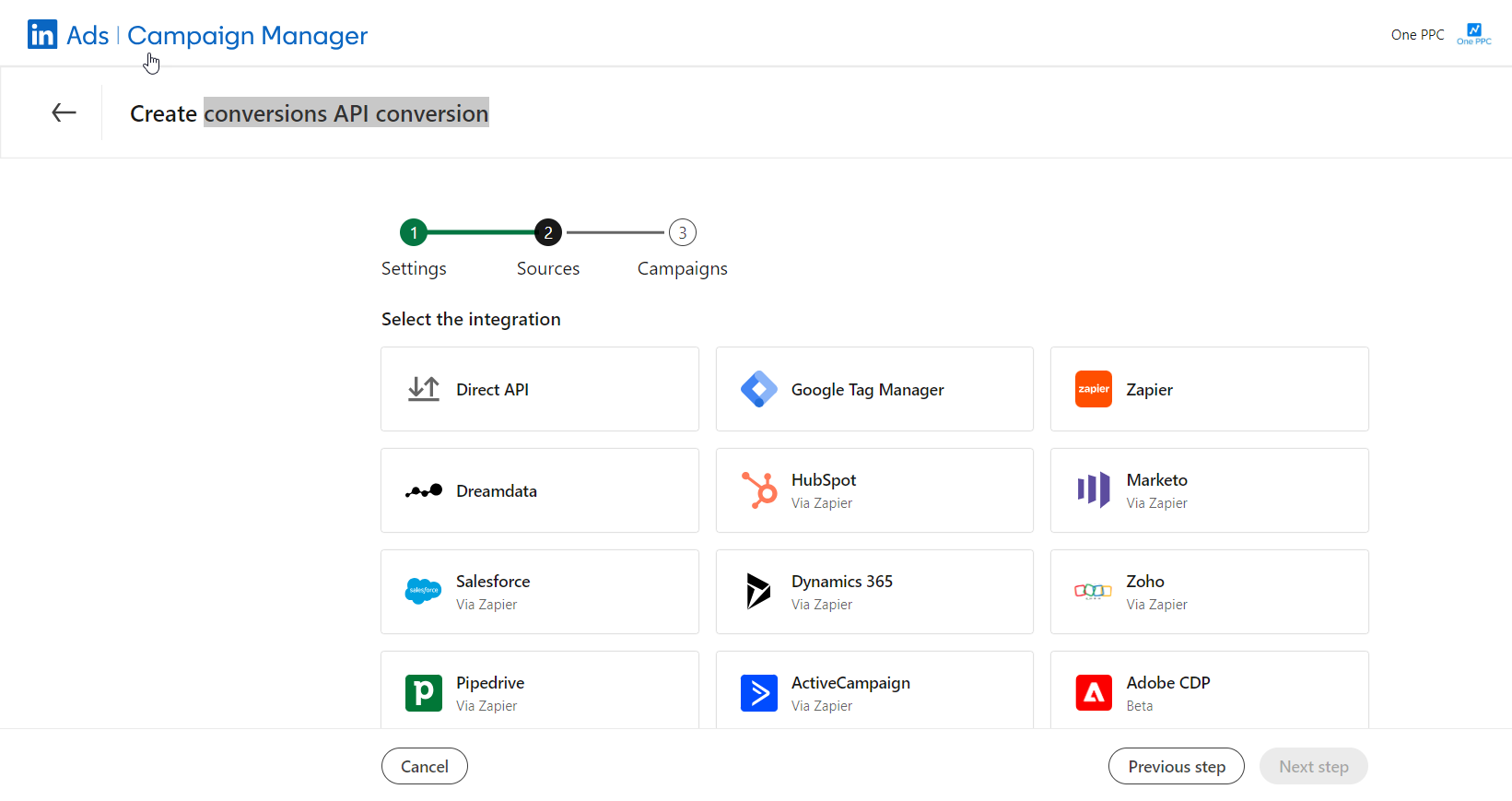
Using Offline Conversion Tracking to Improve Lead Quality
This tracking method enhances advertising by categorising leads into high, medium, and low quality. This categorisation allows for more strategic allocation of budgets towards higher-quality leads through adjusted bids. It integrates changes in CRM lifecycle stages—from initial lead qualification to final customer conversions—back into LinkedIn, thus improving bidding strategies and utilising machine learning processes. This focus on converting leads that are more likely to become customers significantly enhances lead quality.
Moreover, Offline Conversion Tracking can relay sales revenue back to ad platforms, facilitating customer scoring based on revenue value or frequency of purchases. This capability supports a Return on Ad Spend (ROAS) bidding strategy that prioritises higher sales values over mere cost per sale, thereby allowing the system to take customer quality into account. This comprehensive approach ensures that advertising efforts are not only targeted but also economically efficient, driving better business outcomes. Offline conversion tracking should be used in conjunction with online conversion tracking.
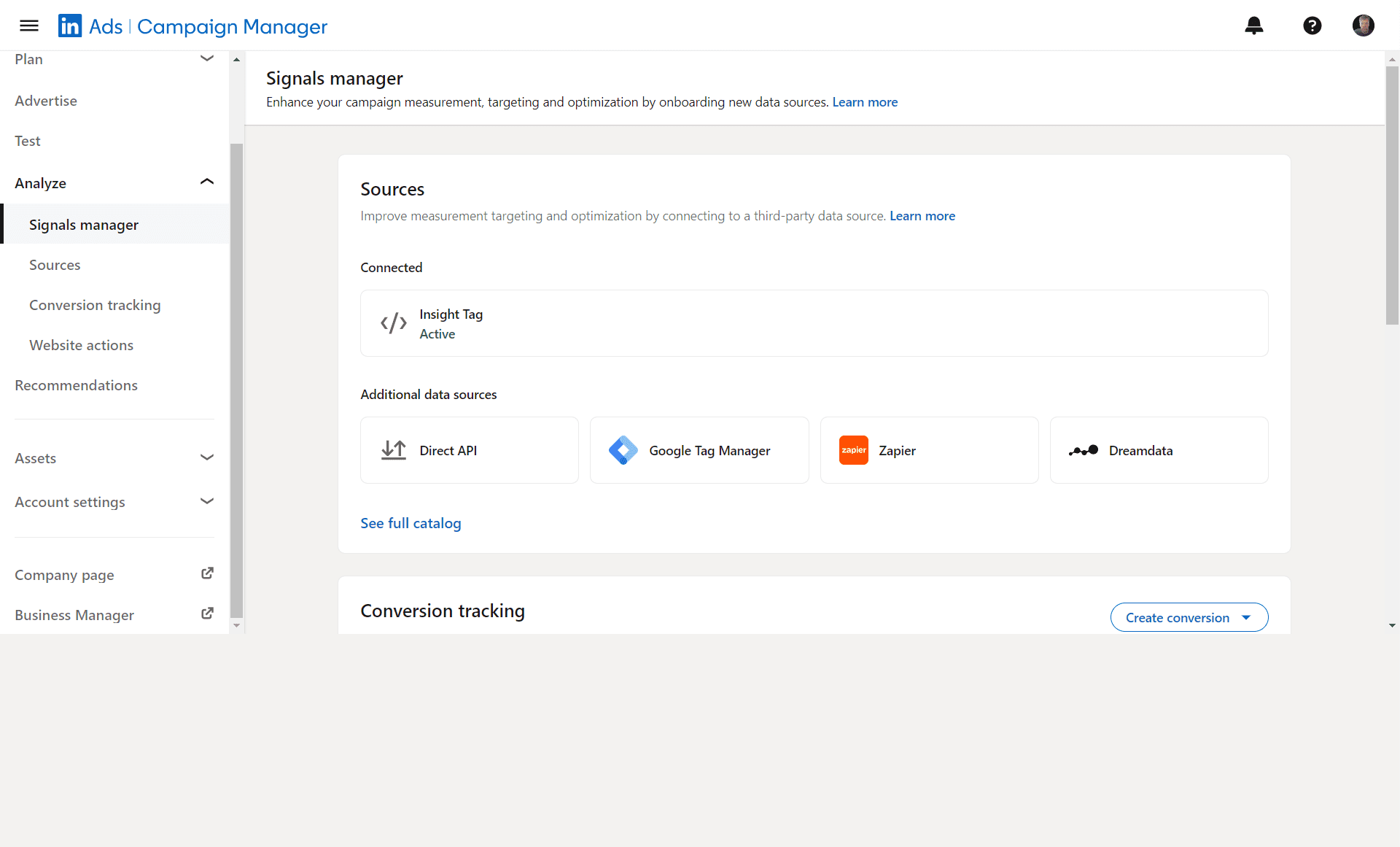
The Origin Backstory of Offline Conversion Tracking
LinkedIn Ads offers both online and offline conversion tracking options, each serving distinct yet complementary purposes. Initially, offline conversion tracking was primarily used to report offline sales, allowing for manual adjustments based on historical data. However, with the advent of machine learning and automation, service providers now leverage offline conversion tracking to train AI systems to improve lead quality.
Online conversion tracking is widely used to increase lead quantity and determine the cost per lead. In contrast, offline conversion tracking is increasingly being used for its ability to optimise lead quality and long-term value.
The primary focus of online conversion tracking is to maximise the volume of leads, commonly utilising bidding strategies such as Target CPA (Cost Per Acquisition) or Max CPA. While this approach efficiently increases lead count, it does not necessarily ensure lead quality.
On the other hand, offline conversion tracking goes beyond just increasing the volume of leads. It involves syncing changes in the lead lifecycle back to LinkedIn Ads as offline conversions occur during the sales cycle. This advanced method enables detailed lead scoring, optimising the advertising budget not only to increase the number of leads and customers but also to attract higher-value customers.
Moreover, offline conversion tracking enhances ROI by adjusting the focus of automated bidding systems towards high-quality leads, ensuring a more targeted and effective allocation of advertising spend. It allows businesses to not only prioritise but also differentiate leads based on their potential to convert into actual sales.
Recognising the disparity in lead value is crucial. While CPA is an important metric, focusing solely on lead cost can overlook the true quality of the leads, potentially leading to wasted expenditure on leads unlikely to convert. To maximise ROI, it is essential to assess both the cost and the value each lead brings to the business. Integrating first-party data from CRMs with advertising targeting can significantly improve campaign efficiency. By focusing on high-quality leads, advertisers can allocate their budgets more effectively, enhancing ROI and attracting customers who contribute long-term value to the business.
Offline conversion tracking provides a comprehensive view of the customer journey, from the initial online ad impression to the final offline conversion.
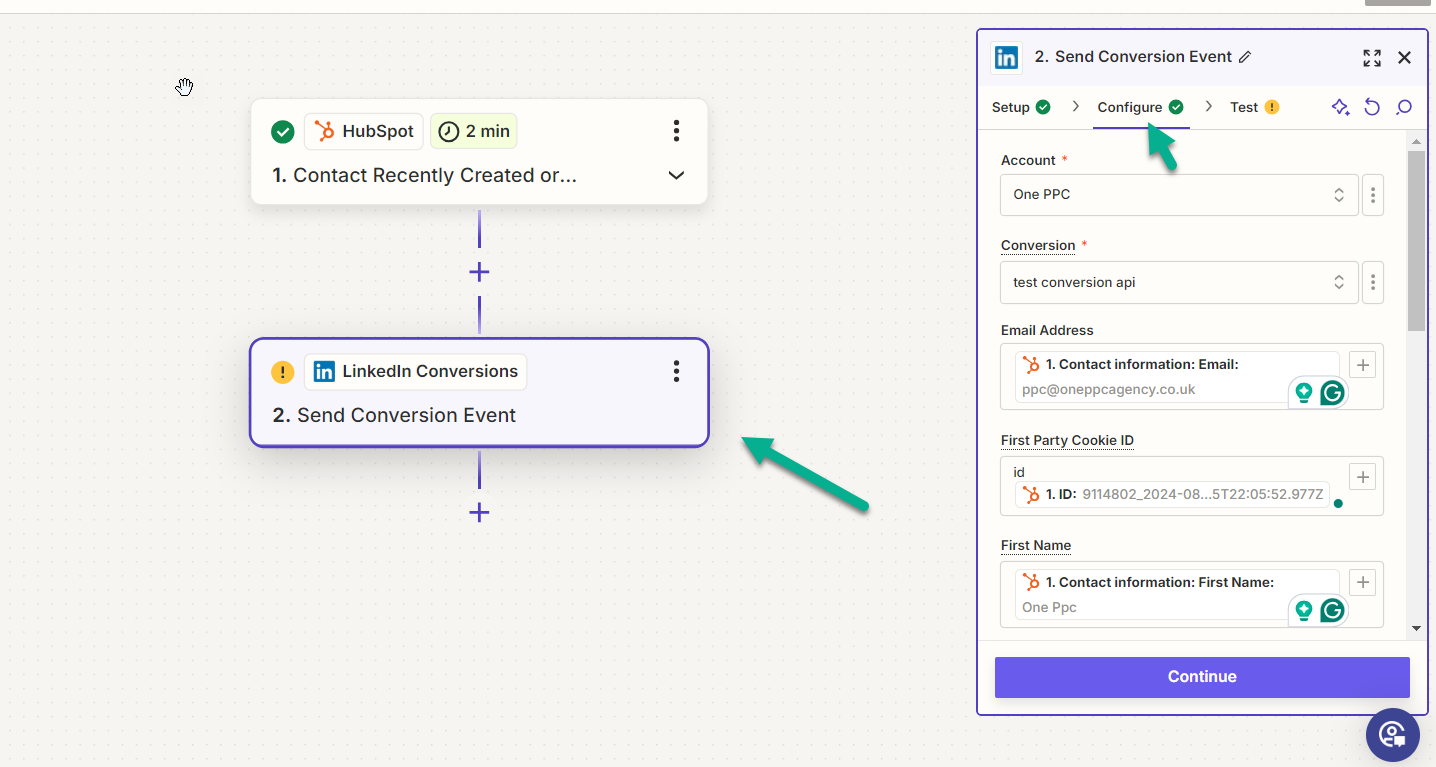
CRM Integration - Offline Conversions
By syncing CRM data on lead stage changes back to LinkedIn Ads, advertisers can rank leads more accurately. This categorisation helps train LinkedIn’s AI to focus on acquiring high-quality leads, thereby improving the overall quality of leads generated.
Utilise offline conversion tracking to relay lead stage updates from your CRM back to LinkedIn Ads, enabling you to score lead quality and evaluate the sales value of leads.
This lets you transcend basic CPA optimisation by incorporating first-party data from CRM systems into LinkedIn Ads, your campaigns can evolve from simple lead-generation efforts to comprehensive revenue-generation systems.
By categorising leads as either converted customers (good), qualified leads (average), or poor (leads that did not progress), LinkedIn’s AI can be refined to focus on acquiring more high-quality leads while minimising the low-quality ones. This capability allows you to allocate a greater budget to higher-quality leads through increased bids.
This enriches the bidding and other machine-learning processes, enabling you to target conversions that are more likely to result in actual customers, thus elevating lead quality.
Furthermore, offline conversion tracking can transmit sales revenue data back to the ad platforms, facilitating customer scoring based on revenue value and/or repeat frequency and lifetime value. This approach allows you to prioritise higher-value customers over lower-value ones. Similar to ROAS (Return on Ad Spend) bidding, this strategy fine-tunes the bidding process to focus on higher sales values rather than merely the cost per sale, enabling the system to incorporate the quality and potential value of your customers into its bidding decisions.
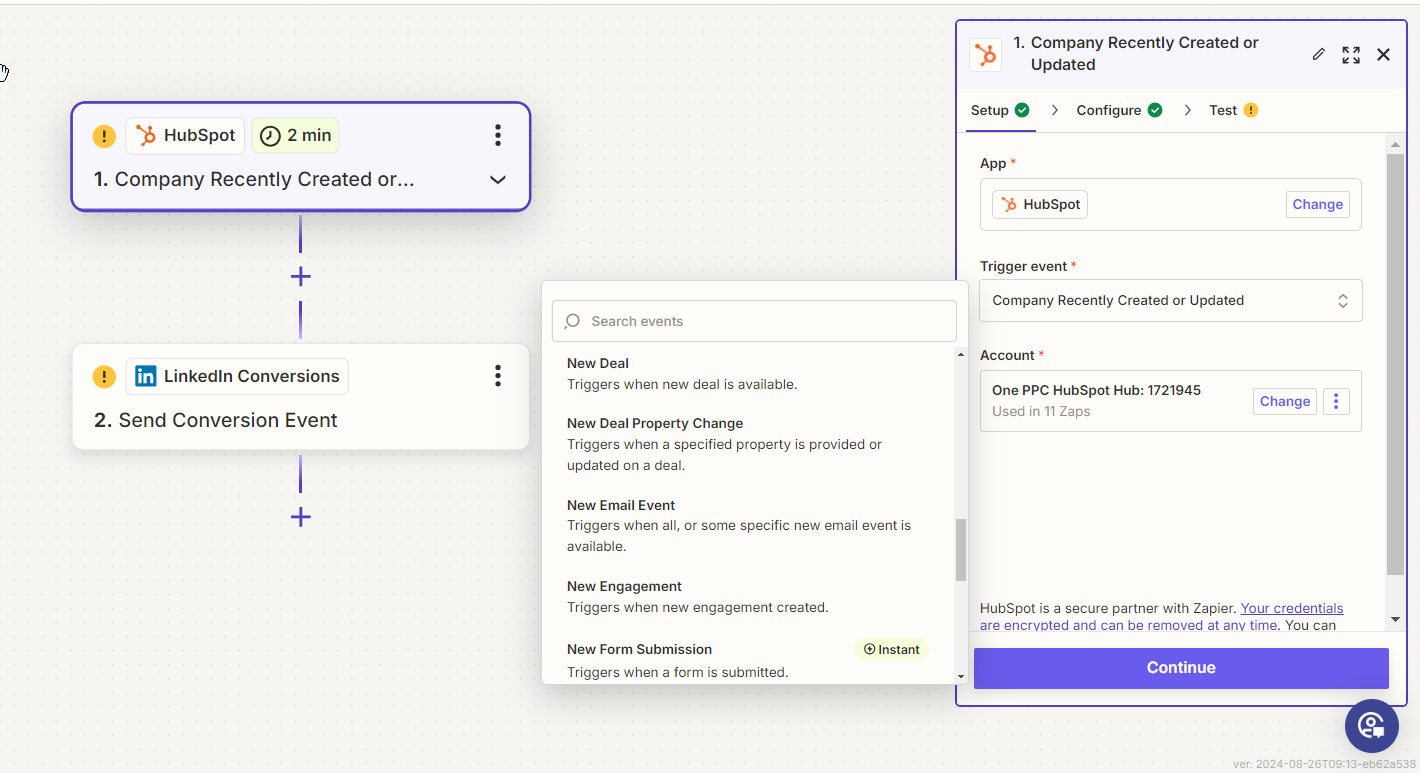
Track Sales Cycle Stages as Offline Conversions
Offline conversion tracking significantly enhances your LinkedIn Ads optimisation by mapping the journey of leads through your sales funnel. By syncing these lifecycle changes back to LinkedIn Ads, you unlock advanced optimisation and reporting features, powered by machine learning AI, to ensure your marketing investments yield tangible results. Enhancing the tracking and integration of offline interactions with your ad campaigns elevates the quality of leads and ensures a more efficient use of your marketing budget.
This integration process with your CRM involves updating advertising platforms as prospects advance through stages in your CRM—such as phone calls, meetings, quotes, and proposals. Automating this process enhances the accuracy of lead scoring within your ad campaigns, offering a holistic view of each customer’s interaction with your business, thereby enabling more strategic advertising decisions.
To extract maximum insights from offline conversion tracking, it’s critical to delineate the conversion process into distinct stages. Although each company’s marketing and sales process may vary, ideally, at least three stages should be identified to classify leads into categories of good, medium, and poor quality. This segmentation enhances the bidding efficacy on ad platforms, directing more budget towards high-quality leads who are most likely to convert, thereby improving your return on investment.
Sending each stage as an offline conversion helps ad platforms optimise for quality leads over quantity. This focus shifts towards attracting leads that have a higher likelihood of becoming paying customers, thereby amplifying the effectiveness of your advertising efforts. By providing detailed feedback at each stage of the sales funnel, you empower the platform’s algorithms to learn and adjust more accurately and efficiently. This strategic approach not only boosts lead quality but also maximises your return on investment by minimizing wasted ad spend and enhancing conversion rates.
Syncing lifecycle stages as offline conversions enables businesses to fine-tune their advertising strategies effectively, ensuring optimal budget allocation and improved overall campaign performance. Let’s explore methods to sync your CRM lifecycle stages to achieve these objectives.
To enhance lead quality beyond CPA bidding, it is essential to incorporate CRM lifecycle changes after the initial lead capture into the ad platform’s bidding algorithm using offline conversion tracking. This approach trains the AI on more relevant prospect and customer data from lower in the funnel.
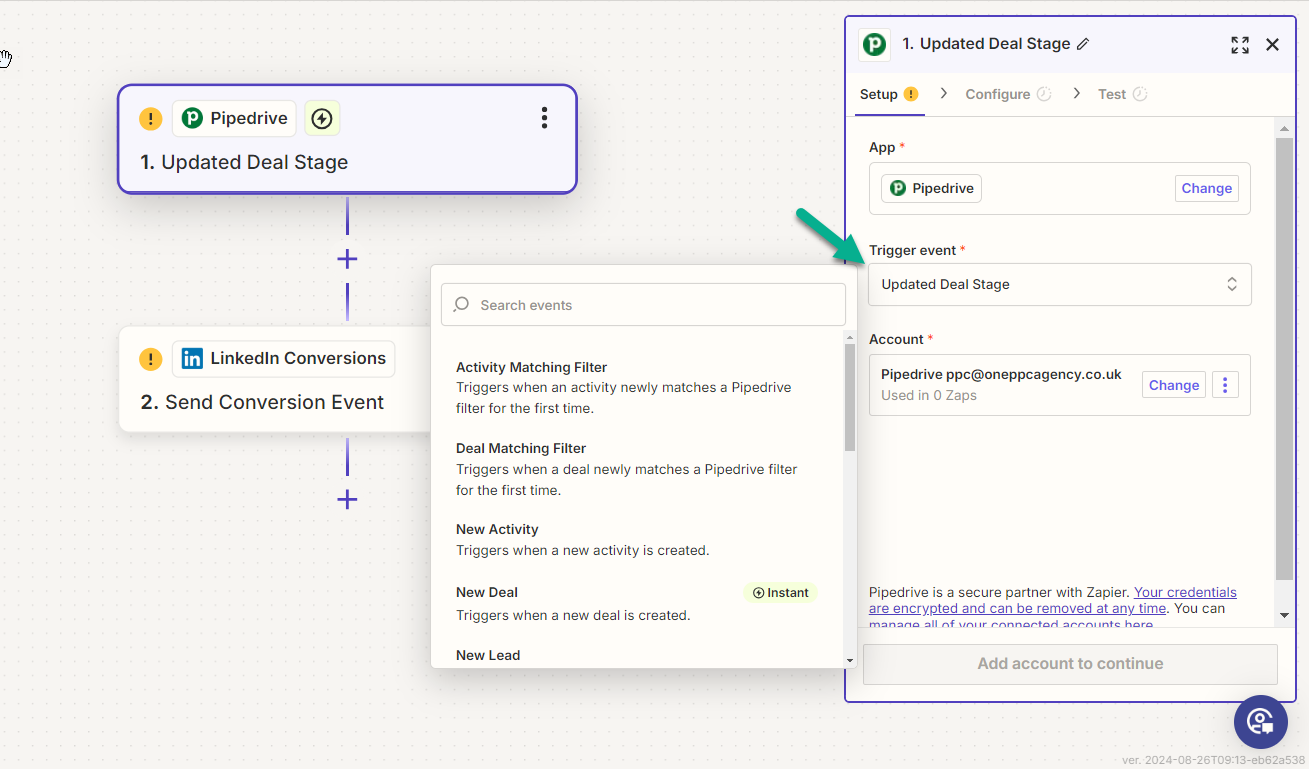
How to Set Up LinkedIn Ads Offline Conversion Tracking
Setting up Offline Conversion Tracking involves choosing the right data-sharing method, configuring your conversions, and linking them to your campaigns. Here’s how to get started:
Step 1: Choose a Data Sharing Method
Manual CSV Upload
Manual CSV Upload: Advertisers can manually upload conversion data using a CSV template.
How it Works: Upload a CSV file of your conversion data directly into Campaign Manager.
Benefits: This method doesn’t require developer resources and gives you full control over your data and upload frequency. A daily or weekly upload is recommended for accuracy.
Tip: Manual uploads can take 24-48 hours or even up to a week to process, so plan accordingly.
Conversions API
Allows for automated, continuous data streaming to LinkedIn.
Partner Integration: LinkedIn offers integrations with various partners like Google Tag Manager, Zapier, and Dreamdata for easier implementation.
How it Works: Use a certified LinkedIn Marketing Partner, such as Google Tag Manager, Zapier, or Dreamdata, to set up an automated data-sharing process via the Conversions API.
Benefits: This option allows for seamless, near real-time data sharing without needing dedicated developer resources.
Direct API Integration:
Direct API Integration: Direct API Integration: For companies with developer resources, a direct integration with LinkedIn’s API is possible.
How it Works: Build a custom integration using LinkedIn’s Conversions API, which requires developer resources and ongoing maintenance.
Benefits: This method is ideal for businesses that need to continuously stream large volumes of data directly to LinkedIn.
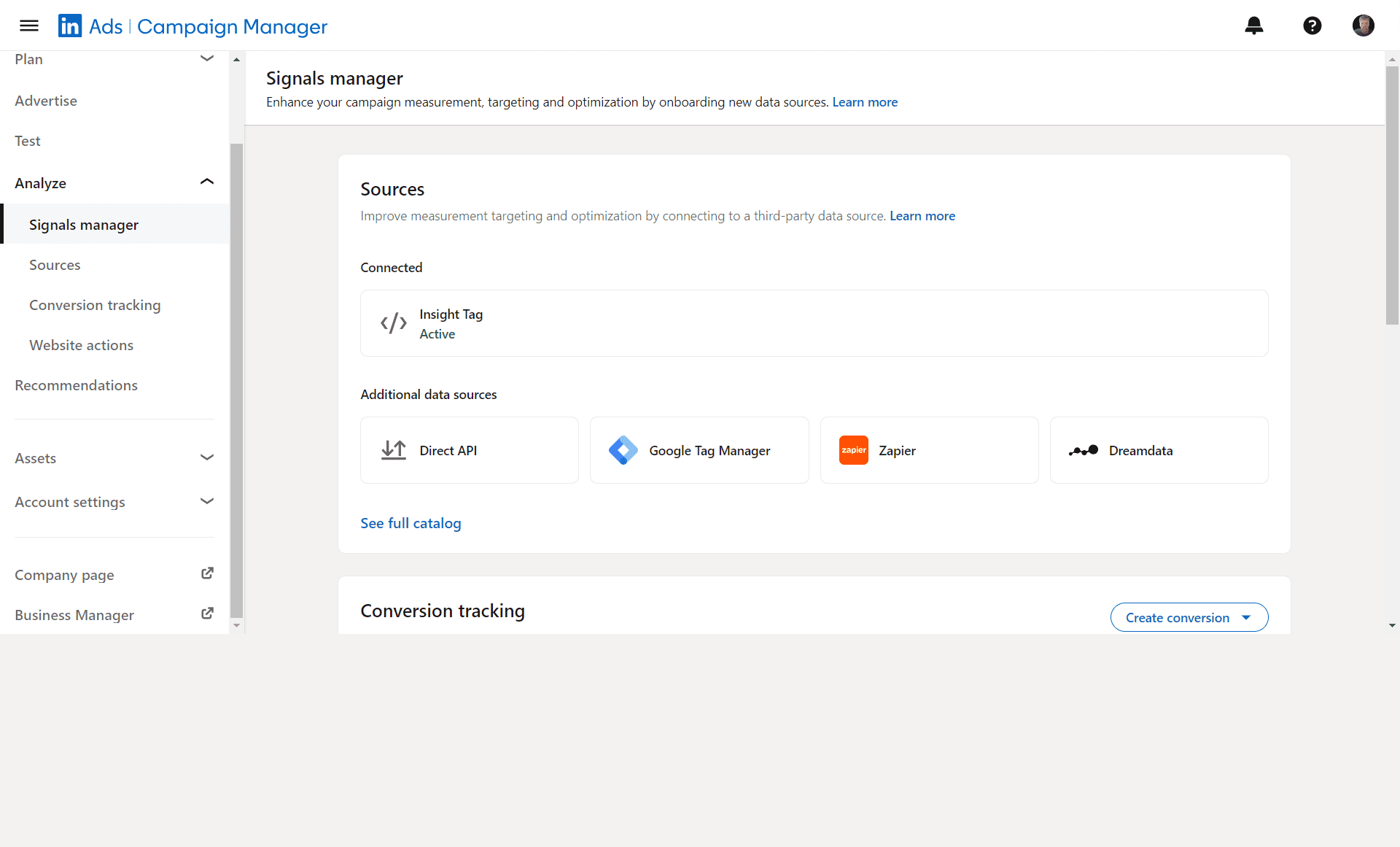
Step 2: Configure Your Imported Conversion
Once you’ve chosen your data-sharing method, the next step is to configure your conversion within LinkedIn Campaign Manager:
- Create a Conversion: Click on ‘Create Conversion’ in Campaign Manager and select the type of conversion you’re tracking (e.g., in-store purchase, phone call lead).
- Define Conversion Details: Set a name for your conversion, specify the type of action, and assign a monetary value if applicable. This helps in calculating ROI.
- Set a Lookback Window: Determine the timeframe during which conversions will be attributed to a campaign after a user interacts with your ad.
- Link to Campaigns: Select the campaigns you want to associate with this conversion. This step is crucial for tracking the performance of your ads.
Step 3: View and Analyse Conversions in Campaign Manager
Once your data is imported and matched, LinkedIn will attribute the conversions to the appropriate campaigns. You can view these results in Campaign Manager at various levels (account, campaign group, campaign, and ad).
- Manual Uploads: Conversion data from manual CSV uploads can take 24-48 hours, sometimes up to a week, to appear.
- API Data: Data sent through the Conversions API will be available in near real-time, providing more immediate insights.
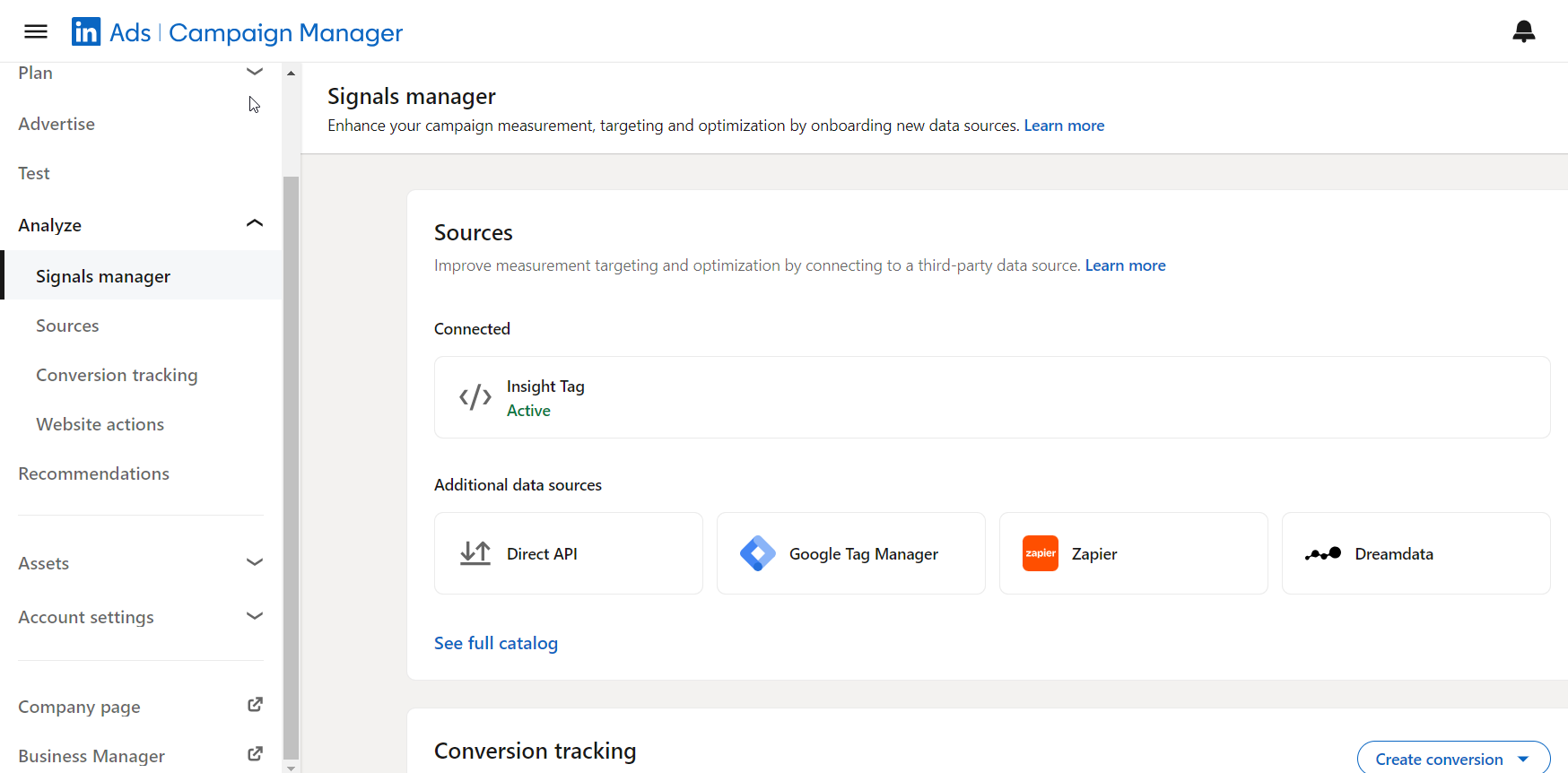
Insight Tag and Conversions API: Better Together
For the most accurate and comprehensive view of your ad performance, consider using both the Insight Tag and the Conversions API. This combination allows you to track online conversions directly from your website and offline conversions through imported data, minimising signal loss and improving the efficiency of your reporting.
Best Practices for LinkedIn Ads Offline Conversion Tracking
To maximise the effectiveness of your Offline Conversion Tracking, follow these best practices:
- Ensure Data Accuracy: The accuracy of your offline data is critical. Make sure the identifiers used (emails, phone numbers) are up-to-date to improve matching rates.
- Regular Data Uploads: Whether you use manual uploads or an API, keep your data current by uploading it regularly—daily or weekly is ideal.
- Analyse and Optimise: Use the insights from your conversions to refine your ad strategies, focusing on what drives real-world results.
A Guide on How to Integrate Your CRM with LinkedIn Ads
Integrating your CRM with LinkedIn Ads is a powerful way to streamline your marketing efforts and enhance your lead generation strategy. This integration allows you to connect LinkedIn’s robust targeting capabilities with your customer data, resulting in more accurate, data-driven campaigns that align with your sales pipeline. Whether you’re aiming to nurture prospects or drive conversions, syncing your CRM with LinkedIn Ads provides valuable insights into your audience’s behaviour, allowing for more precise ad targeting and better ROI.
For a step-by-step guide on how to set up this integration and fully leverage its capabilities, explore our comprehensive Guide to Integrating Your CRM with LinkedIn Ads.
- Optimise Lead Nurturing: Ensure that your LinkedIn campaigns reach high-value prospects at the right stages of their buying journey.
- Refine Targeting: Use CRM data to create highly personalised LinkedIn campaigns based on customer interactions, purchase history, or lead scoring.
- Close the Loop on Reporting: Track the full customer journey, from initial LinkedIn engagement to final offline conversion, and measure the true ROI of your LinkedIn Ads.
- Leverage Machine Learning for AI Optimisation: Utilise LinkedIn’s machine learning algorithms in conjunction with your CRM data to automatically optimise ad delivery, ensuring your campaigns are dynamically adjusted to reach the most engaged and high-quality leads at the optimal times for conversion
Conclusion
LinkedIn Ads Offline Conversion Tracking is a game-changer for businesses looking to bridge the gap between their online advertising efforts and offline business outcomes. By integrating this feature with traditional online conversion tracking, you can gain a more accurate and complete understanding of your campaign performance across the entire customer journey. This dual approach not only enhances your ability to measure ROI but also empowers you to make more informed decisions about ad targeting, budgeting, and optimisation.
As LinkedIn continues to evolve its conversion tracking capabilities, adopting tools like the Insight Tag and Conversions API will be essential for capturing the full value of your campaigns. By following best practices and regularly analysing your conversion data, you can refine your marketing strategies to focus on the actions that drive real-world results, ultimately maximising your return on investment and achieving greater success with your LinkedIn advertising efforts.